新闻英语中比喻类修辞格及其翻译
- 格式:pdf
- 大小:150.28 KB
- 文档页数:3
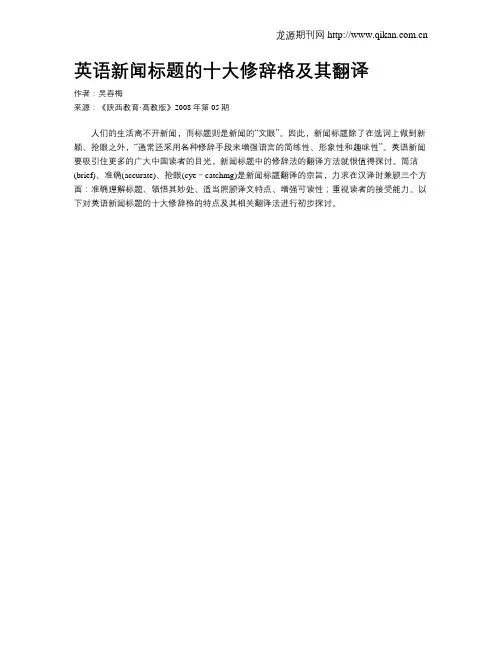
龙源期刊网
英语新闻标题的十大修辞格及其翻译
作者:吴春梅
来源:《陕西教育·高教版》2008年第05期
人们的生活离不开新闻,而标题则是新闻的“文眼”。
因此,新闻标题除了在选词上做到新颖、抢眼之外,“通常还采用各种修辞手段来增强语言的简练性、形象性和趣味性”。
英语新闻要吸引住更多的广大中国读者的目光,新闻标题中的修辞法的翻译方法就很值得探讨。
简洁(brief)、准确(accurate)、抢眼(cye-catchmg)是新闻标题翻译的宗旨,力求在汉译时兼顾三个方面:准确理解标题、领悟其妙处、适当照顾译文特点、增强可读性;重视读者的接受能力。
以下对英语新闻标题的十大修辞格的特点及其相关翻译法进行初步探讨。
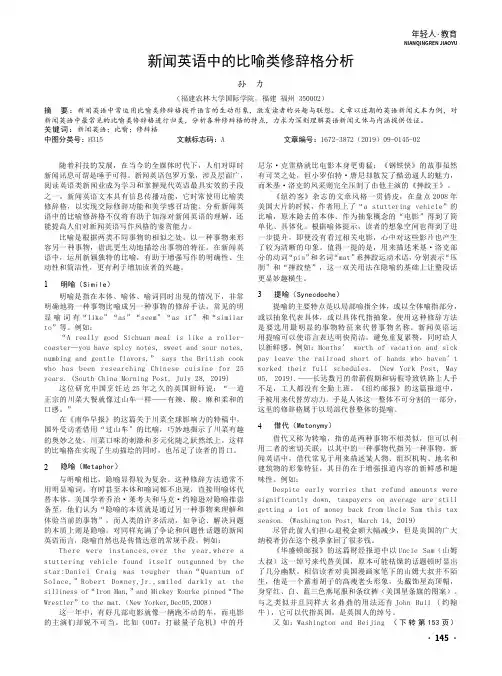
新闻英语中的比喻类修辞格分析孙 力(福建农林大学国际学院,福建 福州 350002)摘 要:新闻英语中常运用比喻类修辞格提升语言的生动形象,激发读者的兴趣与联想。
文章以近期的英语新闻文本为例,对新闻英语中最常见的比喻类修辞格进行归类,分析各种修辞格的特点,力求为深刻理解英语新闻文体与内涵提供佐证。
关键词:新闻英语;比喻;修辞格中图分类号:H315 文献标志码:A 文章编号:1672-3872(2019)09-0145-02随着科技的发展,在当今的全媒体时代下,人们对即时新闻讯息可谓是唾手可得。
新闻英语包罗万象,涉及层面广,阅读英语类新闻业成为学习和掌握现代英语最具实效的手段之一。
新闻英语文本具有信息传播功能,它时常使用比喻类修辞格,以实现交际修辞功能和美学感召功能。
分析新闻英语中的比喻修辞格不仅将有助于加深对新闻英语的理解,还能提高人们对新闻英语写作风格的鉴赏能力。
比喻是根据两类不同事物的相似之处,以一种事物来形容另一种事物,借此更生动地描绘出事物的特征。
在新闻英语中,运用新颖独特的比喻,有助于增强写作的明确性、生动性和简洁性,更有利于增加读者的兴趣。
1 明喻(Simile)明喻是指在本体、喻体、喻词同时出现的情况下,非常明确地将一种事物比喻成另一种事物的修辞手法。
常见的明显喻词有“like”“as”“seem”“as if”和“similar to”等。
例如:“A really good Sichuan meal is like a roller-coaster—you have spicy notes, sweet and sour notes, numbing and gentle flavors,” says the British cook who has been researching Chinese cuisine for 25 years. (South China Morning Post, July 28, 2019)这位研究中国烹饪达25年之久的英国厨师说:“一道正宗的川菜大餐就像过山车一样——有辣、酸、麻和柔和的口感。

!!2005年6月!!!!!!!!!!!!!!!!!!!!!!!!!外国语言文学研究!June2005第5卷第2期!!ResearchinForeignLanguageandLiterature!Vol.5No.2英语新闻标题修辞赏析与翻译李红霞(北京工业大学,北京,100022)摘要:本文首先讨论了英语新闻标题的修辞特点,并结合大量实例分析各种修辞格在新闻标题中的运用,然后提出了如何翻译英语新闻标题的方法。
关键词:英语新闻;标题;修辞!一、引言当今社会,生活节奏越来越快,人们往往是先预览标题,然后再决定要不要看整篇文章。
标题在新闻中的重要性可见一斑,所以,好的标题一定要能唤起读者阅读的兴趣与愿望,给读者留下清新而深刻的印象。
在一定程度上,标题就是新闻的广告(Leiter,Harriss&Johnson,2003)。
为了突出新闻重点、刺激读者的阅读冲动,记者、编辑不惜努力,使英语新闻标题在词汇、语法、修辞、形式等方面形成了自己鲜明的特色,构成了独特的标题语言(head-linese)(转引自许明武,2003)。
本文收集了近两年来在英美主要报刊发表的一些文章的标题,着重分析其修辞特点,并在此基础上总结英语新闻标题修辞的汉译方法。
二、英语新闻标题修辞特点1.简约新闻标题追求简单明了,一目了然。
在英美报刊上我们常常可以看见单词式标题、短语式标题或短句式标题。
另外,使用简短小词,省略一切无实意的词语,如冠词、介词、连词、系动词等,也是常用的手法。
请看下面这则标题:NEETGeneration(TheGuardian,Nov.2,2004)NEET是noteducation,employmentortraining的首字母缩写,指的是一群“不上学,不工作,也不参加培训的年轻人”。
文章讨论了目前在日本和英国的年轻人中存在的NEET现象,并探讨这种现象的社会源。
首字母缩写不仅使文章标题显得简洁,而且因为是作者新造的词,很容易引起读者的兴趣。
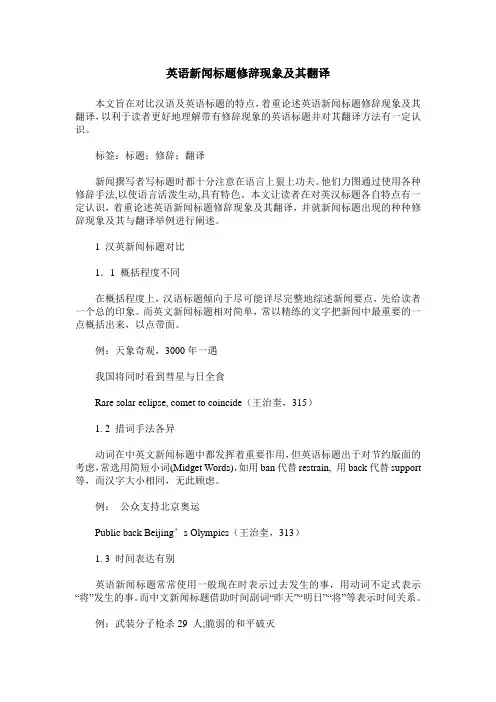
英语新闻标题修辞现象及其翻译本文旨在对比汉语及英语标题的特点,着重论述英语新闻标题修辞现象及其翻译,以利于读者更好地理解带有修辞现象的英语标题并对其翻译方法有一定认识。
标签:标题;修辞;翻译新闻撰写者写标题时都十分注意在语言上狠上功夫。
他们力图通过使用各种修辞手法,以使语言活泼生动,具有特色。
本文让读者在对英汉标题各自特点有一定认识,着重论述英语新闻标题修辞现象及其翻译,并就新闻标题出现的种种修辞现象及其与翻译举例进行阐述。
1 汉英新闻标题对比1.1 概括程度不同在概括程度上,汉语标题倾向于尽可能详尽完整地综述新闻要点,先给读者一个总的印象。
而英文新闻标题相对简单,常以精练的文字把新闻中最重要的一点概括出来,以点带面。
例:天象奇观,3000年一遇我国将同时看到彗星与日全食Rare solar eclipse, comet to coincide(王治奎,315)1. 2 措词手法各异动词在中英文新闻标题中都发挥着重要作用,但英语标题出于对节约版面的考虑,常选用简短小词(Midget Words),如用ban代替restrain, 用back代替support 等,而汉字大小相同,无此顾虑。
例:公众支持北京奥运Public back Beijing’s Olympics(王治奎,313)1. 3 时间表达有别英语新闻标题常常使用一般现在时表示过去发生的事,用动词不定式表示“将”发生的事。
而中文新闻标题借助时间副词“昨天”“明日”“将”等表示时间关系。
例:武装分子枪杀29 人;脆弱的和平破灭Militants Kill 29; Weak Peace Shattered.(The New York Times)2.英语新闻标题修辞现象与翻译英语新闻标题善用各种修辞使语言更具吸引力,翻译此类具有修辞现象的英语新闻标题,不但要熟知英汉新闻标题的特点,遵循各自的语言特色,而且在语言的转换中则应注意与汉语的契合,做到流畅地道,毫无斧凿痕迹。
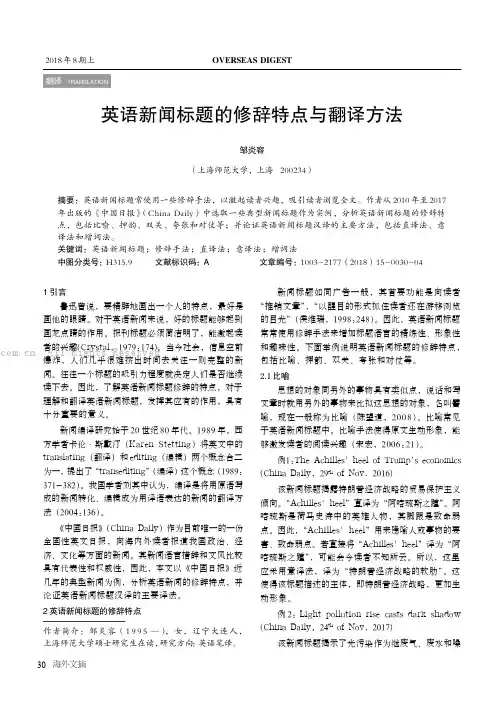
1 引言鲁迅曾说,要精辟地画出一个人的特点,最好是画他的眼睛。
对于英语新闻来说,好的标题能够起到画龙点睛的作用。
报刊标题必须简洁明了,能激起读者的兴趣(Crystal,1979:174)。
当今社会,信息空前爆炸,人们几乎很难挤出时间去关注一则完整的新闻。
往往一个标题的吸引力程度就决定人们是否继续读下去。
因此,了解英语新闻标题修辞的特点,对于理解和翻译英语新闻标题,发挥其应有的作用,具有十分重要的意义。
新闻编译研究始于20世纪80年代。
1989年,西方学者卡伦·斯戴汀(Karen Stetting)将英文中的translating(翻译)和editing(编辑)两个概念合二为一,提出了“transediting”(编译)这个概念(1989:371-382)。
我国学者刘其中认为,编译是将用原语写成的新闻转化、编辑成为用译语表达的新闻的翻译方法(2004:136)。
《中国日报》(China Daily)作为目前唯一的一份全国性英文日报,向海内外读者报道我国政治、经济、文化等方面的新闻。
其新闻语言措辞和文风比较具有代表性和权威性,因此,本文以《中国日报》近几年的典型新闻为例,分析英语新闻的修辞特点,并论证英语新闻标题汉译的主要译法。
2 英语新闻标题的修辞特点新闻标题如同广告一般,其首要功能是向读者“推销文章”,“以醒目的形式抓住读者还在游移浏览的目光”(侯维瑞,1998:248)。
因此,英语新闻标题常常使用修辞手法来增加标题语言的精练性、形象性和趣味性。
下面举例说明英语新闻标题的修辞特点,包括比喻、押韵、双关、夸张和对仗等。
2.1 比喻思想的对象同另外的事物具有类似点,说话和写文章时就用另外的事物来比拟这思想的对象,名叫譬喻,现在一般称为比喻(陈望道,2008)。
比喻常见于英语新闻标题中。
比喻手法使得原文生动形象,能够激发读者的阅读兴趣(宋宏,2006:21)。
例1:The Achilles' heel of Trump's economics (China Daily, 29th of Nov. 2016)该新闻标题揭露特朗普经济战略的贸易保护主义倾向。


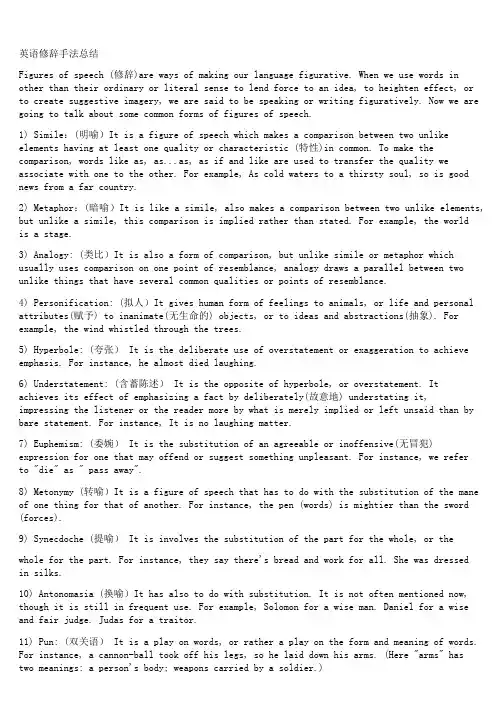
英语修辞手法总结Figures of speech (修辞)are ways of making our language figurative. When we use words in other than their ordinary or literal sense to lend force to an idea, to heighten effect, orto create suggestive imagery, we are said to be speaking or writing figuratively. Now we are going to talk about some common forms of figures of speech.1) Simile:(明喻)It is a figure of speech which makes a comparison between two unlike elements having at least one quality or characteristic (特性)in common. To make the comparison, words like as, as...as, as if and like are used to transfer the quality we associate with one to the other. For example, As cold waters to a thirsty soul, so is good news from a far country.2) Metaphor:(暗喻)It is like a simile, also makes a comparison between two unlike elements, but unlike a simile, this comparison is implied rather than stated. For example, the worldis a stage.3) Analogy: (类比)It is also a form of comparison, but unlike simile or metaphor which usually uses comparison on one point of resemblance, analogy draws a parallel between two unlike things that have several common qualities or points of resemblance.4) Personification: (拟人)It gives human form of feelings to animals, or life and personal attributes(赋予) to inanimate(无生命的) objects, or to ideas and abstractions(抽象). For example, the wind whistled through the trees.5) Hyperbole: (夸张) It is the deliberate use of overstatement or exaggeration to achieve emphasis. For instance, he almost died laughing.6) Understatement: (含蓄陈述) It is the opposite of hyperbole, or overstatement. Itachieves its effect of emphasizing a fact by deliberately(故意地) understating it,impressing the listener or the reader more by what is merely implied or left unsaid than by bare statement. For instance, It is no laughing matter.7) Euphemism: (委婉) It is the substitution of an agreeable or inoffensive(无冒犯) expression for one that may offend or suggest something unpleasant. For instance, we referto "die" as " pass away".8) Metonymy (转喻)It is a figure of speech that has to do with the substitution of the mane of one thing for that of another. For instance, the pen (words) is mightier than the sword (forces).9) Synecdoche (提喻) It is involves the substitution of the part for the whole, or thewhole for the part. For instance, they say there's bread and work for all. She was dressedin silks.10) Antonomasia (换喻)It has also to do with substitution. It is not often mentioned now, though it is still in frequent use. For example, Solomon for a wise man. Daniel for a wise and fair judge. Judas for a traitor.11) Pun: (双关语) It is a play on words, or rather a play on the form and meaning of words. For instance, a cannon-ball took off his legs, so he laid down his arms. (Here "arms" hastwo meanings: a person's body; weapons carried by a soldier.)12) Syllepsis: (一语双叙) It has two connotations.In the first case, it is a figure by which a word, or a particular form or inflection of a word, refers to two or more words in the same sentence, while properly applying to or agreeing with only on of them in grammar or syntax(句法). For example, He addressed you and me, and desired us to follow him. (Here us is used to refer to you and me.)In the second case, it a word may refer to two or more words in the same sentence. For example, while he was fighting , and losing limb and mind, and dying, others stayed behind to pursue education and career. (Here to losing one's limbs in literal; to lose one's mindis figurative, and means to go mad.)13) Zeugma: (轭式搭配) It is a single word which is made to modify or to govern two or more words in the same sentence, wither properly applying in sense to only one of them, or applying to them in different senses. For example, The sun shall not burn you by day, nor the moon by night. (Here noon is not strong enough to burn)14) Irony: (反语) It is a figure of speech that achieves emphasis by saying the opposite of what is meant, the intended meaning of the words being the opposite of their usual sense. For instance, we are lucky, what you said makes me feel real good.15) Innuendo: (暗讽) It is a mild form of irony, hinting in a rather roundabout (曲折)way at something disparaging(不一致) or uncomplimentary(不赞美) to the person or subject mentioned. For example, the weatherman said it would be worm. He must take his readings in a bathroom.16) Sarcasm: (讽刺) It Sarcasm is a strong form of irony. It attacks in a taunting and bitter manner, and its aim is to disparage, ridicule and wound the feelings of the subject attacked. For example, laws are like cobwebs, which may catch small flies, but let wasps break through.17) Paradox: (似非而是的隽语) It is a figure of speech consisting of a statement or proposition which on the face of it seems self-contradictory, absurd or contrary to established fact or practice, but which on further thinking and study may prove to be true, well-founded, and even to contain a succinct point. For example more haste, less speed.18) Oxymoron: (矛盾修饰) It is a compressed paradox, formed by the conjoining(结合) of two contrasting, contradictory or incongruous(不协调) terms as in bitter-sweet memories, orderly chaos(混乱) and proud humility(侮辱).19) Antithesis: (对照) It is the deliberate arrangement of contrasting words or ideas in balanced structural forms to achieve emphasis. For example, speech is silver; silence is golden.20) Epigram: (警句) It states a simple truth pithily(有利地) and pungently(强烈地). It is usually terse and arouses interest and surprise by its deep insight into certain aspects of human behavior or feeling. For instance, Few, save the poor, feel for the poor.21) Climax: (渐进) It is derived from the Greek word for "ladder" and implies the progression of thought at a uniform or almost uniform rate of significance or intensity,like the steps of a ladder ascending evenly. For example, I came, I saw, I conquered.22) Anti-climax or bathos: (突降)It is the opposite of Climax. It involves stating one's thoughts in a descending order of significance or intensity, from strong to weak, from weighty to light or frivolous. For instance, But thousands die, without or this or that, die, and endow(赋予) a college, or a cat.23) Apostrophe: (顿呼) In this figure of speech, a thing, place, idea or person (dead or absent) is addressed as if present, listening and understanding what is being said. For instance, England! awake! awake! awake!24) Transferred Epithet: (转类形容词) It is a figure of speech where an epithet (anadjective or descriptive phrase) is transferred from the noun it should rightly modify(修饰) to another to which it does not really apply or belong. For instance, I spent sleeplessnights on my project.25) Alliteration: (头韵) It has to do with the sound rather than the sense of words for effect. It is a device that repeats the same sound at frequent intervals(间隔) and since the sound repeated is usually the initial consonant sound, it is also called "front rhyme". For instance, the fair breeze blew, the white foam flew, the furrow followed free.26) Onomatopoeia: (拟声) It is a device that uses words which imitate the sounds made by an object (animate or inanimate), or which are associated with or suggestive(提示的) of some action or movementExplanation version1一、什么是修辞格修辞格(figures of speech)是提高语言表达效果的语言艺术。
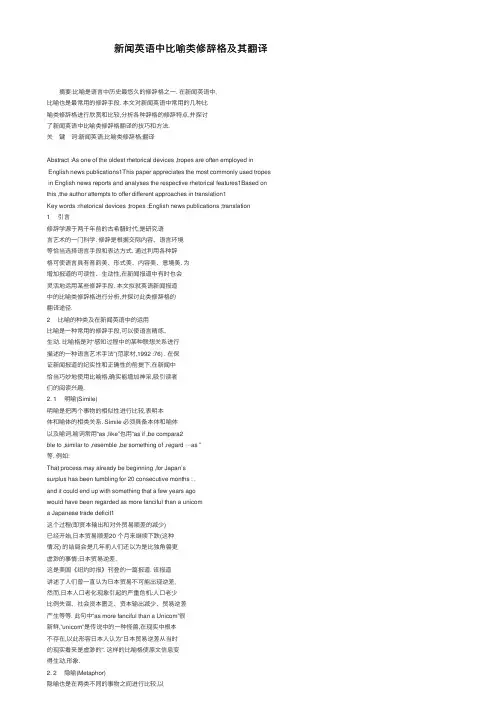
新闻英语中⽐喻类修辞格及其翻译摘要:⽐喻是语⾔中历史最悠久的修辞格之⼀. 在新闻英语中,⽐喻也是最常⽤的修辞⼿段. 本⽂对新闻英语中常⽤的⼏种⽐喻类修辞格进⾏欣赏和⽐较,分析各种辞格的修辞特点,并探讨了新闻英语中⽐喻类修辞格翻译的技巧和⽅法.关 键 词:新闻英语;⽐喻类修辞格;翻译Abstract :As one of the oldest rhetorical devices ,tropes are often employed inEnglish news publications1This paper appreciates the most commonly used tropes in English news reports and analyses the respective rhetorical features1Based on this ,the author attempts to offer different approaches in translation1Key words :rhetorical devices ;tropes ;English news publications ;translation1 引⾔修辞学源于两千年前的古希腊时代,是研究语⾔艺术的⼀门科学. 修辞是根据交际内容、语⾔环境等恰当选择语⾔⼿段和表达⽅式. 通过利⽤各种辞格可使语⾔具有⾳韵美、形式美、内容美、意境美. 为增加报道的可读性、⽣动性,在新闻报道中有时也会灵活地运⽤某些修辞⼿段. 本⽂拟就英语新闻报道中的⽐喻类修辞格进⾏分析,并探讨此类修辞格的翻译途径.2 ⽐喻的种类及在新闻英语中的运⽤⽐喻是⼀种常⽤的修辞⼿段,可以使语⾔精练、⽣动. ⽐喻格是对“感知过程中的某种联想关系进⾏描述的⼀种语⾔艺术⼿法”(范家材,1992 :76) . 在保证新闻报道的纪实性和正确性的前提下,在新闻中恰当巧妙地使⽤⽐喻格,确实能增加神采,吸引读者们的阅读兴趣.2. 1 明喻(Simile)明喻是把两个事物的相似性进⾏⽐较,表明本体和喻体的相类关系. Simile 必须具备本体和喻体以及喻词,喻词常⽤“as ,like”也⽤“as if ,be compara2ble to ,similar to ,resemble ,be something of ,regard ⋯as ”等. 例如:That process may already be beginning ,for Japan’ssurplus has been tumbling for 20 consecutive months : ,and it could end up with something that a few years agowould have been regarded as more fanciful than a unicoma Japanese trade deficit1这个过程(即资本输出和对外贸易顺差的减少)已经开始,⽇本贸易顺差20 个⽉来继续下跌(这种情况) 的结局会是⼏年前⼈们还以为是⽐独⾓兽更虚渺的事情:⽇本贸易逆差.这是美国《纽约时报》刊登的⼀篇报道. 该报道讲述了⼈们曾⼀直认为⽇本贸易不可能出现逆差,然⽽,⽇本⼈⼝⽼化现象引起的严重危机:⼈⼝⽼少⽐例失调、社会资本匮乏、资本输出减少、贸易逆差产⽣等等. 此句中“as more fanciful than a Unicom”很新鲜,”unicom”是传说中的⼀种怪兽,在现实中根本不存在,以此形容⽇本⼈认为“⽇本贸易逆差从当时的现实看来是虚渺的”. 这样的⽐喻格使原⽂信息变得⽣动,形象.2. 2 隐喻(Metaphor)隐喻也是在两类不同的事物之间进⾏⽐较,以表明两者的相似之处. 但它不⽤喻词连接本体和喻体. 从构成⽅式上,隐喻分为“显露式隐喻”(VisibleMetaphor) 和“⾮显露式隐喻”( Invisible Metaphor) 两种. ⾮显露式隐喻⼜可分为两种,⼀种是本体出现,喻体缺;另⼀种是喻体出现,本体缺.1) 显露式隐喻显露式隐喻的本体和喻体在上下⽂⾥同时出现,典型的⽐喻词是to be. 例如:“The Chinese market is a bottomless pit”, said thevisiting Nike CEO here in Shanghai1正在上海访问的耐克公司⾸席执⾏官如是说:“上海的市场⽆限巨⼤”.此句中的“a bottomless pit”指“⽆底洞”,意指其发展潜⼒很⼤. 通过喻体“⽆底洞”形象地向读者传达出市场的发展前景.2) ⾮显露式隐喻(1) ⼀种是喻体不完全直接出现,⽽是通过其他词(多为动词) 折射出来,表⽰隐喻关系. 例如:“The domestic environment is soft”,notes Manson of Donaldson ,Lufkin&Jennette1“If it stays that way ,Mattel’s sales will eventually succumb1But it should be able to weather the storm1The firm’s best ballast against rough seas lies with European consumers1”“国内环境是疲软的”,D - L - J 公司的曼逊说1“假如持续下去,马特尔玩具商店的销售最终会陷⼊窘境. 但是它应有能⼒度过难关. 这家商店对付风险的最佳稳定因素在于它的欧洲消费者. ”本体是European consumers , 通过weather , thestorm ,ballast ,rough seas ,读者可以体会European con2 sumers 的强⼤和稳定的市场需求. “weather”与“storm”反映出玩具商店在商业风暴中的窘境,但“ballast”(原义是船上的压舱物) 和“rough seas”折射出稳定的欧洲消费群体将帮助平稳地渡过这次销售难关. 该例句中本体不完全直接出现,⽽是由喻体提⽰. 这样给读者很多的想象空间.(2) ⼀种是喻体出现,本体由喻体暗⽰,通过上下⽂读者可⽴刻意识到. 因此给读者很多想象的空间. 例如:Clearly a tug of war over key policies continues be2 tween the pragmatic and ideological camps1(Newsweek) 不⾔⽽喻,注重务实的和强调意识形态的两⼤营垒还会在重⼤政策问题上争吵不休.句中原义是“拉绳⼦(拔河) 的游戏”,在例⼦⾥隐喻义是“争吵不休”. 通过喻体的联想,读者可意会出本体是the disputes between the pragmatic and ideo2 logical camps12. 3 借代(Metonymy)借代是不直接说出⼈和事物的本来名称,⽽借⽤⼈和事物特征性的词代替. 作⽤是通过相近联想,⽤⼀事物取代另⼀有关事物. 例如:The proposal to protect the hundreds of thousands of Kurdish refugees seemed dependent on the whims of Sad2 dam Hussein or that it would have to be given muscle by a multinational force1保护⼏⼗万库尔德难民的计划看来要依靠萨达姆·候赛因的⼼⾎来潮. 或者必须以多国部队的武⼒做后盾. (muscle”原意为“肌⾁”,在此句中借以代替“⼒量”)在描述⼈物、地名和建筑物时,借代修辞格使⽤更频繁. 如:White House ⽩宫⼀指美国政府,Pentagon五⾓⼤楼⼀指美国国防部,Hollywood 好莱坞⼀美国电影业/ 电影界,Wall Street 华尔街⼀美国⾦融界, Beijing 北京⼀中国政府.2. 4 提喻(Synecdoche)提喻是不直接说出⼈和事物的本来名称,⽽以部分代替全体,具体代替抽象,单个代替类别,或者反过来以全体代替部分,抽象代替具体,类别代替单个. 例如:Last year nearly 518 million vehicles rolled off the assembly lines1去年将近⽣产出580 万辆汽车.Vehicle 是运载⼯具,汽车只是运载⼯具的⼀种,是全体代替局部.3 新闻英语中⽐喻类修辞格的翻译⽅法由于⽐喻类修辞格在新闻中的使⽤,在翻译中我们既要维护新闻的客观性,⼜应保留其原汁原味的特⾊.3. 1 保留原⽂形象如果某种修辞⼿段译成汉语后不会使读者产⽣理解上的困难,则可直译或基本直译. 这样不仅给译语输⼊新鲜的⾎液,还会让读者体会异国情调之美.例如:The Open Barn Door (Newsweek) 敞开的粮仓⼤门(⽐喻美国科技情报容易获取)Children Under Parents’Wing (China Daily ,Oct18 , 2002)原⽂标题中形象地⽤翅膀来⽐喻⽗母的保护,读者接受这种喻体,可直译为:⽗母“翅膀”底下的孩⼦.3. 2 改变原⽂形象,译出喻义当原来的形象难以保留,为保证原信息传达的效果,必须改变形象. 例如:The 40 - plus summiteers are a mixed bag from Eu2 rope ,Africa ,the Middle East ,Asia ,the Americas and the Pacific1法语国家⾸脑会议是个⼤杂烩,有来⾃欧洲、⾮洲、中东、亚洲、美洲和太平洋地区的四⼗个国家的⾸脑参加.上例中如直译出“a mixed bag”,不易被译语读者接受,相反,⽤意义相近的形象表⽰出来,既保留了原⽂信息,⼜在译⽂中再现了与原⽂相似的形象.3. 3 舍弃原⽂形象,译出喻义如果修辞⼿法在语⾔的转换中难以直接完整地表达原意,不得不舍弃原⽂的字⾯意义,以求译⽂与原⽂的内容相符. 例如:An admixture of wealth , rivalry and instability has made the Middle East a brimming cauldron of the trade , accounting for a third of the world’s arm deals1 ——— Times ,Oct 21 ,1981中东地区富庶如油、冲突迭起、动荡不安,军⽕⽣意⼗分⽕爆,占世界武装交易(总额) 的三分之⼀.此句中的“a brimming cauldron of the trade”字⾯意思是“⼀⼝滚沸欲溢的⼤锅. ”若⼀味追求保存喻体的形象,直译后的译⽂将会让⼈费解. 因此,该句舍弃了原⽂形象,以确保读者能够理解准确.4 结束语新闻是⼀种对事实准确性要求极强的⽂体,⽽渗透其中的修辞格使抽象的事物具体化,让概念的东西形体化,唤起读者的丰富联想. 在翻译英语新闻报道中的修辞格时,⼀⽅⾯应该正确地处理原⽂的喻义,最⼤限度地传递原语信息,另⼀⽅⾯⼜不要拘泥于原⽂,⽣搬死译. 因此,当⽐喻的“形”、“义”不能兼顾时,只好舍“形”取“义”.参考⽂献:[1 ] 曹明伦. 谈英语报刊新闻的基本特点及其翻译[J ]1 中国翻译,2005 , (6) :87 - 881[2 ] 陈浩东. 从⽂化视⾓谈英语新闻报刊标题的汉译[J ]1 社科纵横,2002 , (3) :60 - 611[3 ] 邓曼娜. 浅析英语新闻报刊⽂体的翻译[J ]1 西南科技⼤学学报,2004 , (3) :88 - 941[4 ] 范家材. 英语修辞赏析[M]1 上海:上海交通⼤学出版社,19921[5 ] 胡曙光. 英语修辞学[M]1 上海:上海教育出版社,20021[6 ] 刘宓庆. ⽂体与翻译[M]1 北京:中国对外翻译出版公司,19981[7 ] 张健. 新闻英语⽂体与范⽂评析[M]1 上海:上海外语教育出版社,19941。

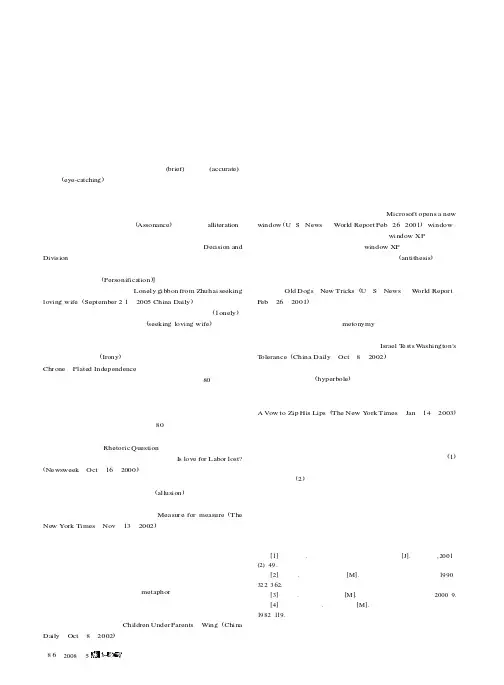
56英语新闻标题的十大修辞格及其翻译人们的生活离不开新闻,而标题则是新闻的“文眼”。
因此,新闻标题除了在选词上做到新颖、抢眼之外,“通常还采用各种修辞手段来增强语言的简练性、形象性和趣味性”。
英语新闻要吸引住更多的广大中国读者的目光,新闻标题中的修辞法的翻译方法就很值得探讨。
简洁(brief)、准确(accurate)、抢眼(eye-catching )是新闻标题翻译的宗旨,力求在汉译时兼顾三个方面:准确理解标题、领悟其妙处、适当照顾译文特点、增强可读性;重视读者的接受能力。
以下对英语新闻标题的十大修辞格的特点及其相关翻译法进行初步探讨。
押韵:押韵包括元韵(Assonance )和头韵(alliteration )等。
元韵“是指连续几个词重复同一个或近似的元音,求取悦耳效果的辞格”,而头韵读来则很有节奏感,如“Decision and Division ”就是利用头韵来加快句子的节奏,让读者读起来朗朗上口。
拟人:拟人(Personification )]使句子更加生动、形象,让读者产生一种亲切感。
如:Lonely gibbon from Zhuhai seeking loving wife (September 21,2005China Daily )在此标题中,长臂猿被赋予了人的情感:孤独(1onely );以及人的行为方式:寻找爱妻(seeking loving wife )。
读者读后不禁莞而一笑,自觉甚是有趣。
译文:《珠海一孤独长臂猿苦寻爱妻》反语:反语(Irony )旨在通过发笑达到讽刺的目的。
如:Chr one —Plated Independence这则新闻标题嘲弄的是一个每年只能生产出80万吨铬的小国扬言要完全独立。
用直译加注解的方法来翻译,保留了原语的幽默与讽刺意味,同时,译文读者还能得到与原文读者大致相同的感受。
译文:《铬板式的独立—年产80万吨铬的小国扬言要完全独立》设问:设问(Rhetoric Question )就是“用疑问句的方式增强语言表达效果的一种修辞方式。
英语报刊新闻常用修辞解读在英语报刊新闻中,修辞手法是常用的一种表达方式。
修辞手法可以增强新闻的表现力和感染力,使新闻更加生动、有趣,引起读者的共鸣。
本文将介绍英语报刊新闻中常用的修辞手法,并对其进行解读。
一、比喻比喻是一种将不同事物之间的相似之处进行对比的修辞手法。
在英语报刊新闻中,比喻常用于描述抽象的概念或事件,使其更加形象化,易于理解。
比如:1. The city was a sea of lights.(这个城市是一片灯海。
)2. The new policy is a ray of hope for the poor.(新政策为穷人带来了一线希望。
)3. The politician was a wolf in sheep's clothing.(那位政治家是个披着羊皮的狼。
)二、排比排比是一种将同类型的词语、短语或句子进行并列的修辞手法。
在英语报刊新闻中,排比常用于强调某种情感或观点,使其更加生动、有力。
比如:1. We will fight for freedom, we will fight for justice, and we will fight for our rights.(我们将为自由而战,为正义而战,为我们的权利而战。
)2. The company's goals are clear: to innovate, to expand,and to succeed.(公司的目标很明确:创新、扩张、成功。
)3. The candidate promised to reduce taxes, to create jobs, and to improve education.(那位候选人承诺要减税、创造就业机会、改善教育。
)三、反问反问是一种表达方式,即用疑问的形式来表达肯定的意思。
在英语报刊新闻中,反问常用于表达强烈的情感或观点,引起读者的共鸣。
比如:1. Are we really going to let this injustice continue?(我们真的要让这种不公继续下去吗?)2. Do we really want to live in a world without clean water and air?(我们真的想生活在没有清洁水和空气的世界吗?)3. Is this the kind of society we want to live in?(这是我们想生活的社会吗?)四、夸张夸张是一种夸大事物的修辞手法。
英语体育新闻标题修辞赏析与翻译一、引言体育新闻由于报道内容的特别性,在传递体育赛事信息的同时,往往也要注重信息本身的娱乐效果。
一个绝妙的体育新闻标题不仅能迅速抓住读者眼球,而且能够在信息性和娱乐性之间找到完美平衡,从而使阅读成为一种美的体验。
笔者从国内外权威主流媒体中搜集大量的语料,对其进行分析研究后发现,英语体育新闻经常使用的用于提高其可读性和娱乐性的方法主要有以下三种:(1)语音修辞,比如押韵和谐音;(2)意义修辞,包括比喻、拟人、夸张、对比等;(3)句法修辞,主要表现为大量使用对偶句。
在接下来的篇幅中,笔者将对英语体育新闻标题中的绝妙佳句从上述三个方面进行分析,并根据新闻标题简洁醒目的特点,同时参照相关翻译理论,对其做尝试性的翻译。
二、语音修辞语音是语言的物质外壳,是语言存在的外部形式。
运用语音修辞,可以使得语言的韵律感与音乐美得到充分体现。
英语体育新闻为了产生醒目同时又能入耳的效果,通常会追求词语之间音的押韵、形的一致和节奏的对称。
正如英国现代作家毛姆在总结自己的创作体会时说:“词有其力、其音、其形;惟考虑这些方能写出醒目入耳之句。
”1.头韵1)Wenger:I’ll mke Brc brek the bnk for Fb.――The SunWenger(温格)是英超阿森纳足球俱乐部的主教练,Fb(法布雷加斯,俗称小法)是他手下的一名优秀球员。
而现在西班牙著名足球俱乐部巴萨(Brc)要购买法布雷加斯,温格主教练肯定不会轻易把爱徒给别人。
标题中的“Brc”,“brek”和“bnk”这三个押头韵的词非常醒目,不但把主教练温格的态度表现得淋漓尽致,同时也使得新闻标题读起来富有节奏,充满韵律,让人过目不忘,回味无穷。
具体到这条新闻的翻译,由于汉语中不太注重押头韵这种修辞,而同时要找到押头韵又能传递原文信息的词句难度相当大,所以笔者在这里采取了设问加四字格的运用以此提高标题的醒目度。
译:温格:想买小法?我会让巴萨倾家荡产――《太阳报》2)Soft spoken Solderling lets rcket do the tlking――Chin Dily瑞典XX球选手索德林(Soldering)在法国公开赛中遭遇劳伦特(Lurent)。
英语报刊新闻报道中比喻现象的翻译第l7卷第6期2004年l2月南京理工大学(社会科学版) JournalofNanjingUniversityofScienceandTechnology,,0l_l7NO.6Dec.2Oo4英语报刊新闻报道中比喻现象的翻译胡光(南京理工大学人文与社会科学学院,江苏南京210094)摘要:本文通过对英语报刊新闻报道中的大量比喻现象进行分析,对英汉两种语言中喻体形象进行比较.在此基础上提出翻译时对喻体现象的处理方法,即保留喻体,替换喻体,省略喻体,并就此探讨比喻翻译的途径.关键词:保"形"保"义";替换喻体;舍"形"取"义"中图分类号:H059文献标识码:A文章编号:1008-2646(2004)06-70-05引言比喻是一种常用的修辞手段,它可以使语言精练,生动,增加语言的具体性,实感性.英国文学评论家理查兹(IvorArmstrongRichards)曾说:"人们时时刻刻都在运用比喻,我们不可能流畅连贯地说上三句话不用比喻."…这话乍看似有夸张之嫌,但却说明了比喻在言语表达中的重要地位.英语新闻报道写作在崇尚新闻报道的纪实性,正确性的原则和前提下,灵活巧妙地借助某些修辞手段.以增加报道的可读性,生动性,从而更好地吸引读者,扩大新闻的传播面和宣传效果.一篇新闻报道通常由三个部分组成:标题(fieadline),导语(1ead)和主体(body).比喻不仅常常出现在新闻报道的导语和主体中,而且也频频在新闻标题中"亮相".现代社会人们生活节奏f3益加快,可供选读的报刊杂志令人眼花缭乱.因此,为能吸引读者的注意力,英语报刊新闻报道除了选取人们普遍关注的轰动性要闻外.往往不遗余力地在新闻标题的语言文字和表达技巧上大做文章,力求标题短小精悍,新颖别致,发人深省.本文拟就英语新闻报道中的比喻现象同汉语中的比喻现象进行比较,并在此基础上探讨翻译的途径.一,喻体形象异同的比较I.喻义相同,喻体形象相同'人类本身以及赖以生存的一切外部条件,包括地理状况,生态环境,季节更迭,气候变化,乃至整个社会文化背景都存在着种种共性,正是这种种共性形成了人类对自身及外部世界的种种共识.正是这些共识,使英汉两种截然不同的语言中某些比喻的设喻存在着惊人的相似之处.两者在本体,喻体现象和设喻形式上完全对应的时而有之,两者的修辞效果也几乎完全等值,这里略举数例: ItwasadramaticcomebackforClinton,whoonlytwoyearsagowasreelingfromtheconservat ivelandslidein Congressandawkwardlyinsistingthathewasstillpoliticallyrelevant.——ChinaDaily,Nov.7,1996.就在两年前,克林顿在国会中保守派排山倒海般的胜利面前栽倒下来,并难为情地坚持说他自己仍然是政治上不可忽视的人物,此次他卷土重来,再显身手,极富戏剧性.收稿日期:2004—09—19作者简介:胡光(1971一),女,山东平阴人,南京理工大学人文与社会科学学院专业英语系讲师.—-7c}-一Palestine,atinyplace,straddlesoneoftheworld'Spoliticalfault—line.Thecrackfromthesmallpointthreatensthepeaceoflargernations,theeconomyofeveryoilimporter.巴勒斯坦这块弹丸之地,坐落在世界某个星带上.断层上一小点裂缝,就会威胁许多比它大的国家的和平,威胁每个石油进口国的经济.China'SLegalloophole.——.TheAmericannewsweekly.VIEWSWEEK,June9,1998.中国法规的漏洞.以上数例有力地说明了英汉两种语言比喻中喻体相同,喻义相同的设喻方式.如:例(1)中"landside"与汉语中的"排山倒海':不就十分吻合吗?这种惊人的"吻合"绝非纯粹的巧合,我们从英汉两个民族认识上的共性和思维方式的共和就可找出产生这一现象的真正原因.2.喻义相同,喻体形象不同由于地理环境,文化传统,劳动方式,社会风俗,历史背景等因素的不同,各民族的文化不可避免地具有其独特的个性.各民族往往从各自的认知角度和联想心理,描形摹状托物言"喻".因此,英汉两种文化的比喻中所采用的喻体形象凸显差异,表现出明显的民族特色.喻义相同而喻体形象相异,即意似而形不似的情况,也不乏其例:ItwasthefirsttimethatMr.Clinton,whoisfacingthemostseverepoliticalcrisisofhiscareer,pi ckedthePentagonasthebackdrop.foramajoraddress.这是克林顿在他的政治生涯中面临的最严峻的危机,他把五角大楼(美国国防部)作为解决这一重大问题的挡箭牌.We'renowonarollercoasterofinflation,witheachpeakhigherthanthepreviousone.——-l7.S.NEWS&WORLDREPORT,Dec,15,1980当前通货膨胀潮起潮涌,瞬息万变,通货膨胀节节攀升.Financially,too,streetcleaninghasbecome呈!g!竺P 竺!,withthedepartmentspendingeightcentsofeverysanitationdoUar一一$25miUionoutof$299million-.onstreetcleaning.————.TheNewY orkTime.Aug,8,1980从开支上看,马路清洁工作成了一个不受人重视的弃儿,其在卫生局的总开支299000000美元中只占25000000美元,即每1美元中只占8美分.比喻负载着大量的民族文化信息,反映着宏阔的文化背景,具有浓郁的民族色彩,以上四例比喻都很好地发挥了各自的语言优势,虽"貌离"但"神合",达到了异曲同工,相得益彰的表达效果.如例(2)中"arollercoasterofinflation"将通货膨胀比作像游乐场里的"过山车一样越转越高",而汉语将此比作"像潮水一样越涨越高",两者中的喻体形象符合两个民族独特的认识观和各自习惯的设喻方式,"殊途同归".二,翻译时对喻体形象的处理及译法1.保留喻体(直译)喻体形象及喻义都完全相同的英汉对应比喻可采取直译,以再现原喻体形象,保持原文比喻的表现力和感染力,尽可能做到形神皆似."为了保留原文修辞的特色,我们对这类修辞格应尽可能采取直译".位但是,采取直译也有一定的条件.刘密庆教授在《文体与翻译》一书中谈到直译时说,原文和译文在内容和形式上都能统一(或基本统一),因此按"原文的表述形式转换,仍可在意义对应转换的前提下保证译文的优劣不受损害."p因此,在翻译英语新闻报道中的比喻时应把握好使用直译的分寸,切忌生搬硬套的"死译".例如:Bythetimewefinishedthecourse,severalsignificantpiecesofinformationwerealreadyin!竺!cyberspacehistory_withitsbeingwritteninnanoseconds.—_TheChristianScienceMonitor,Feb.18,1998当我们完成课程时,好几条重要的信息已经扔进了网络空间的历史垃圾堆——而这一历史是以十亿分之一秒写成的.电脑互联网时代信息的产生,交流,老化速度快得惊人,一个刚刚才产生的重大信息很可能因为仅跟其后的新信息的产生而被甩在后面,新信息瞬间成了"旧"信息,被毫不留情地丢进了电脑网络空间的历史垃圾堆,"thedustbinofhistory"这一比喻与汉语中的"历史的垃圾堆"的喻体形象和喻义完全相同,如出一71—一辙.因此,翻译时,采用直译法,保留喻体,这样有利于保留原比喻的民族特色,重现原文比喻的形象性和生动性,真正做到形神皆似,达到最佳的翻译效果.译界耆宿许渊冲先生曾提出翻译"三美"的标准,即"音美","形美","意美".英语新闻报道翻译不像诗歌翻译那样,特别讲究翻译的音韵美,它更强调形美,意美.此外,保留原喻体形象有利于英汉两种文化的交流与融合,有利于丰富两种语言的表现力.有利于保持比喻的原汁原味和语言的鲜活性.例如: TheSovietshavespurtedupwardtochallengetheU.S.forthedubiousdistinctionofbeingthed ominantmerchanto—fde—ath.——_Times,Oct,21,1981苏联业已跃居鳌首,与美国争夺头号死亡贩子的并不光彩的名声.本世纪80年代初,美国与前苏联两个当时的超级大国在第三世界中竞相争夺军火市场,军火销售额直线飚升,给世界和平蒙上了浓浓的阴影.美苏两国你追我赶,愈演愈烈的军火贸易大战使它们公然成为屠戮生灵的两大"刽子手".此句比喻中"thedominantmerchantofdeath",译成"最大死亡贩子".鲜活生动的比喻让人仿佛看到两大军火销售大国使许多无辜的生命血肉横飞的悲惨场面.将美苏两大军火销售国比作"死亡刽子手"易唤起受众对它们的滔天罪行进行无情控诉的悲愤感情,从而保留了原文比喻的"原汁原味",收到了很好的新闻传播效果.不仅英语新闻报道中的比喻应尽力移植原喻体形象,而且在其它文学作品的翻译中也是如此."译者应尽力把西方文学中千姿百态的比喻忠实地传达给中国读者,为他们带来一种新鲜的愉悦感."不可否认,汉语之所以能保持蓬勃的生命力并"与时俱进",是因为具有兼容性和开放性,能不断吸收英语和其他语言的表达方式,不断筛选和接受新词语.报刊等新闻媒体对外来词,新词新义的反应最为敏感,许多外来词和新词最先是通过报刊等新闻媒体得到记录和普及的.再看看下面出现在报刊新闻报道中的一则比喻:Thatprocessn)ayalreadybebeginning,forJapan'Ssurplushasbeentumblingfor20consec uti vemonths,andit couldendupwithsomethingthatafewyearsagowouldhavebeenregardedasmorefaneifultha naunicorn,aJapanesetradedeficit.——TheNewY orkTimesSeptember22.1996这个过程(即资本输出和对外贸易顺差的减少)已经开始,日本贸易顺差20个月来继续下跌(这种情况)的结局会是几年前人们还以为是比独角兽更虚渺的事情:13本贸易逆差.这是美国《纽约时报》刊登的一篇题为《人口老化的世界出现新的皱纹》的长篇报道.该报道讲述了日本人口老化现象引起的严重危机:人口老少比例失调,银行储蓄减少,社会资本匮乏,贷款利率上升;资本输出减少,贸易逆差产生等等.作为曾是世界第一债权国的日本,人们曾一直认为日本贸易不可能出现逆差,这种担心简直是杞人忧天,然而,日本人口日益老龄化的趋势使日本家庭人口结构出现了倒金字塔现象:老年人多于年轻人,这篇特写无异于给人们敲了警钟:日本人口老化现象不可等闲视之!此句中"……asmorefimcifulthanaunicorn……"比喻之新奇,让人有一种耳目一新之感,"unicorn"是传说中的一种怪兽,在现实中根本不存在,用它来形容日本人认为"日本贸易逆差从当时的现实看来是虚渺的"这一意思时有异曲同工之妙,移植这一喻体"不仅同样能传达原文的信息而且还能引人新的形象,丰富我们的文化意象."2.替换喻体喻义相同而喻体形象相异的英汉比喻,由于无法在译语中再现原喻体形象,完全抛弃它又太可惜,这时较好的做法是:用译语读者所熟悉的形象来代替原喻体形象,要求译语与原语最大限度等值.机械地照搬原文,有时不仅不能保持原文的表现力和感染力,反而会弄得辞不达意,晦涩难懂,甚至歪曲原意.这时,就需要改变原文的喻体形象.只有这样才能准确表达原文的思想和精神,符合译语习惯.当然,若能做到形神兼似,那当然最好,例如:TheCup-ClincheroveraJapaneseteamthatrefusedtoadmitdefeatafterbeingdowntwosetsc anleontheheelsofa—se—e—-—s—aw—five—setwinovertheUnitedStatedonSunday.该队是在星期日那场艰苦的5局拉锯战中击败美国队后,又马不停蹄地迎战日本队时得胜捧杯的,虽然日本队先丢两局后还不肯认输.此句中"see—saw",原意是"翘翘板".我们知道,翘翘板一头压下时另一头就会向上翘起,如此这般一72—循环反复.此处用翘翘板形容日本队与美国队的对抗赛,让我们仿佛身临其境观看一场你先丢一局我后扳一局,一时难分高下的激烈比赛.但是,若为保留喻体照字面直译成"象翘翘板似的5局比赛",不大符合汉语的习惯表达方式,显得有些别扭,读起来也不够通顺,因此,这时可用译语读者所熟悉的等值喻体来替换英语中的喻体,即将"asee—sawfive--set"译成"5局拉锯战".两相比较,汉语中的"拉锯战"丝毫不比英文中的"翘翘板"逊色,两者都生动形象,都能收到极佳的联想效果和修辞效果,从而最终达到很好的宣传报道效果,再举例如下:TheChineseareanationofmerchants,saidaJapanesediplomat,withdisdainmixedwithfeart hattheno—holds—barredChinesebrandofcommerceeventuallycouldoverwhelmthemorecontrolledJapanes emode1.——Newsweek.Aprill2.1993一位日本的外交官轻蔑地说:"中国人很有商业头脑",话语中流露着害怕中国人那无孔不入的经商方法最终会压倒较有拘束的日本经商模式的语气.此句中"no—holds—barred"的原意是"没有船舱被关闭的",若将句中比喻直译成"没有船舱被关闭的经商方法",译语读者看了定会如坠云里雾里,不知所云.况且汉语中也不说"经商方法"像"没有被船舱关闭的",这种搭配方式显然有悖汉语的习惯表达方式,因此,翻译时不妨进行喻体替换,译为"无孔不入的经商方法"既传神达意又生动形象.喻体转换达到了和原语喻体相同的修辞效果,充分发挥了译语的优势."处理难译现象的一种理想方式是在译文语言中找到另一个形象,这个形象与原文的形象具有对应的含义,能产生对等的交际效果."II候维瑞'Ⅲ'KennethKomoski,executivedirectoroftheEducationalProductsandInformationExchang eInstitute,saysthatit remainstobeseenwhetherhomecomputerswill"driveatechnologicalandinstructionalwed gebetweenhomeand!竺,or"providethebasisforcooperative,community—wideeducationalexperiencesforallfamilies."———THEFUTURIST.August1983教育仪器与信息交换所的执行主任肯尼斯?科莫斯基说:"家用电脑在技术和教学这两方面是使家庭与学校之间隔着一堵墙还是为社区范围内的所有家庭的教育合作提供基础,只有拭目以待了."肯尼斯?科莫斯基在谈到家用电脑在技术和教学这两方面给家庭和学校到底带来了好处还是坏处时,用了一个非常形象的比喻:"driveawedgebetweenhomeandschool".这一比喻原指"在家庭和学校之间打进楔子",但若这样翻译,汉语显然有些不通,原比喻的形象贴切就会大打折扣,幸好,汉语中有一个类似的比喻,即"在家庭和学校之间隔着一堵墙"可用来替换原喻体形象.这样,原文比喻与译文比喻意义基本等值,原比喻的形象I生和生动性便基本保全了.3.舍"形"取"义"英汉两个民族的巨大差异往往造成英汉比喻不对应而出现空缺项,原喻体中的形象既无法在译语中再现,译语中也没有喻体形象可以取而代之.对这类比喻的翻译,唯一的办法是只能舍弃原喻体形象,由形象转为非形象,译出其喻义便可.如下例所示; "TheChinesemarketisabottomlesspit",saidthevisitingNikeCEOhereinShanghai.正在上海访问的耐克公司首席执行官如是说:"上海的市场无限巨大".此句中"abottomlesspit"乍一看,似乎可直译为"无底坑",但稍加思索,便不难发现这种译法不妥.因为汉语中并没有"无底坑"这一说法,所谓的"无底坑"实际上应指"无底洞",意思是"永远填不满的洞(多用于比喻).'但是,若据此将Nike公司首席执行官的话试译为"上海市场是一个无底洞",读起来就感觉别扭,因为在实际生活中很难听到中国人讲"市场是个无底洞".有鉴于此,为了使译文更加言简意明,直截了当,不妨舍弃原文的喻体形象,直接译出其意思,即"上海的市场无限巨大".正所谓鱼和熊掌不可兼得,当形义发生矛盾时,只好舍"形"取"义".又如: Anadmixtureofwealth,rivalryandinstabilityhasmadetheMiddleEastabrimmin$cauldron ofthetrade,accountingforathirdoftheworld'Sal'insdeals.——.Times.Oct.21,1981中东地区富庶如油,冲突迭起,动荡不安,军火生意十分火爆,占世界武装交易(总额)的三分之一.此句中的"abrimmingcauldronofthetrade"一看便知是个比喻,字面意思是"一口滚沸欲溢的大锅."若将此句译为"(军火)生意是一口滚沸欲溢的大锅",译文受众则可能难以想象军火生意与滚沸欲溢的大一73—锅之间究竟有什么样的关系,这样一来,原文中的比喻不仅不易于译文受众理解,反而给他们设置了理解的障碍,完全失去了比喻的"初衷"——把抽象难懂的事物说得通俗易懂.而且,如果为了勉强保住喻体形象的生动,将"abrimmingcauldronofthetrade"译为"如火如荼的(军火)生意",似乎也不大妥当.根据《现代汉语词典》,"如火如荼"的意思是"象火那样红",象荼(茅草的白花)那样白.原来比喻军容之盛,现在用来形容旺盛,热烈或激烈."可见,用"如火如荼"来修饰"军火生意"不当,喻体替换不成功.也就是说,此时在翻译英语比喻时碰到一种进退两难的困境:一方面,移植喻体直译行不通;另一方面,进行文化嫁接——用汉语(基本)等值喻体来替换告失败.既然"保留喻体"和"替换喻体"两大翻译手段都无法奏效,那么我们只好拿出最后的"杀手锏"——舍形取义.由此得出,在"形"与"义"不能两全的情况下,只好译出比喻的意思:"abrimmingcauldronofthetrade"译为"(军火)生意十分火爆".但是,我们"强调神似,并不意味着无视原文的民族文化气质和色调,无视形似."…再如: ButcountryVScountryteamcompetitionislosingitslusteramongUSAprosinrecentyearsas .b....i.g......p...u....r..s...e.—s—,whichbroughtbiggerendorsementdeals,becameavailabletograndslamtournamentchampions. ——USAToday,September18,1997但是对于美国职业赛手来说,国际间的团体竞赛近年来已渐趋式微,因为只要能赢得锦标赛大满贯冠军,赞助大赛的大奖是不愁不到手的.此句中,读者不难发现"bigpurses"是此比喻句的喻体,那么对这一喻体形象翻译又该如何处理呢?若照字面硬译为"大钱袋,大钱包",结合整个句子的上下文来看,显然又不对题.根据对上下文的理解,宜舍形求义,译为"(大赛)的大奖",这样一来就使整个句子文通句顺,简洁明了,"形象与喻义的关系是在一种特定文化背景中结合而约定俗成的,反映出一个民族特有的文化心理和欣赏习惯.文化缺省现象是翻译过程中难以避免而又无可奈何的遗憾,大可不必为此而去牵强附会追求字面对等."【目应当承认,以上翻译时对英语新闻报道中喻体形象的处理方法丧失了原文喻体形象的生动性,形象性,鲜活性,以及由此引起的受众的联想和情感反应,这不能不说是英语新闻报道中比喻翻译的一种遗憾,一个败笔.但这样做委实是"不得已而求其次",倘若硬是拘泥于原文而死译,生搬硬查,译出的比喻句势必牵强,读起来拗口,译文受众不但不能领略到原文比喻鲜活贴切的艺术魅力反而觉得比喻得有些"牛头"不对"马嘴".因此,当比喻的"形","义"不能同时兼顾时,"义"是第一位的,"形"是第二位的.当必须在形义两者中作出选择时,只好舍"形"取"义"."只要基本精神传达了,译文的重点宜放在译文的可读性上,也就是在某种不得以的情况下舍'形'取'义'."例参考文献【1】胡文仲.文化与交际[MI.北京:外语教学与研究出版社.1994.【2】冯庆华.实用翻译教程[MI.上海:上海外语教育出版社,1997.【3】刘宓庆.文体与翻译[MI.北京:中国对外翻译出版公司,1998.【4】史志康.文学译海拾贝[J】.耿龙明.翻译论丛[MI.上海:上海外语教育出版社.1998.【5】谢天振.文学翻译:文化意象的失落与歪曲【A】.耿龙明.翻译论丛【c】.上海:上海外语教育出版社,1998.【6]侯维瑞.文学形象的民族性和翻译【A】.耿龙明.翻译论丛【c】.上海:上海外语教育出版社.1998.【7】中国社会研究院语言研究所词典编撰室.现代汉语词典【M].北京:商务印书馆,1996.【8】8张健.新闻英语文体与范文评析[MI.上海:上海外语教育出版社.1994. [919张健.报刊新词英语纵横[MI.上海:上海科技教育出版社,2001.(责任编辑:张叔宁) OntheTranslationofFiguresofSpeechinEnglishNewsPublicationsHUGuangAbstract:Thispaperisintendedtomakeacomparisonbetweenthereferencesonbothlanguag es.Basedonthis,theauthorattemptstOofferdifferentapproachestothereferencesintranslation.i.e.retainthereference,substitut ethereference,andomitthereference.Keywords:retentionofbothreferenceandmeaning;substitutionofreference;omissionofref erenceforretentionofmeaning一74—。